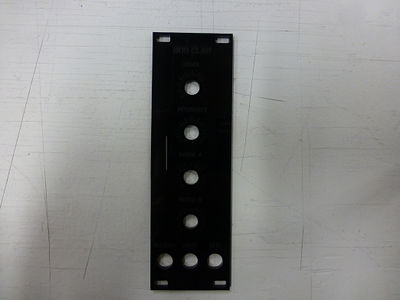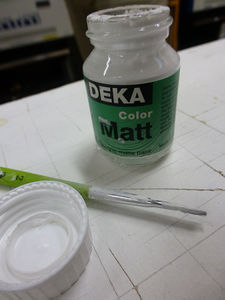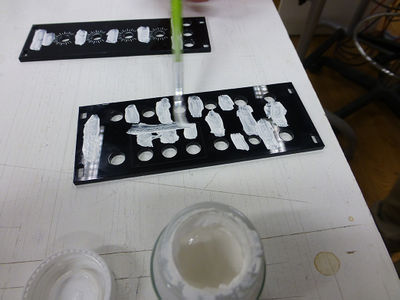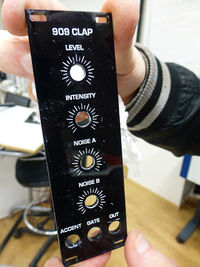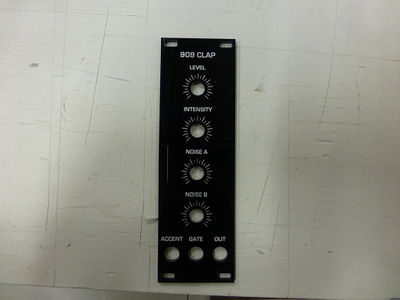Analog modular synthesizer panel
Project date: September 2014
Design made by: Arnar Már Ólafsson
Design made at: Fab_Lab_Reykjavík with the lasercutter.
I am now in the process of making a fully functional analog modular synthesizer. All the panels have been made in Fablab so far. The modular consists of various oscillators, filters, envelope generators, LFOs, sequencers, drum modules, amplifiers, clock dividers, noise sources, sample and hold and other function generators.
Contents
Making a panel
Step 1. prepare design & lasercut.
Following the Eurorack standard of panel sizes, plexiglass panels can be made in Inkscape and then cut in the lasercutter.
Holes for pots, jacks and screws can be cut out by making the lines 0.01 mm thin. Letters, pictures and scales are engraved in the plexiglass.
Step 2. Add paint
By painting the panel with commonly available acrylic paint the engraved features become very visible.
Once the panel comes out of the laser cutter, a layer of acrylic paint is applied to the engraved areas.
Step 3. Clean
The panel is left to dry for a few minutes. Using a moist cloth, the paint is washed off the panel,
it should come off easily, except for the engraved parts, where the paint gets stuck.
Step 4. Repeat
It is often necessary to repeat the procedure once or twice for a smooth look,
sometimes a little bit of the paint gets washed out of the engraved areas.
Once painted and dried out, the panel is then mounted to the potentiometers or jack sockets on the printed circuit board, and the module is complete.
about project
In the last decade or so there has been a growing DIY, open source community online that revolves around the making of analog modular synthesizers. The modular synthesizers were the earliest musical synthesizers. A modular synthesizer is made up of individual modules, that are not hardwired together, unlike the ones that make up most commercial keyboard synthesizers, but rather connected externally with patch cables. The individual modules can be signal or control voltage sources, such as oscillators, envelope generators or low frequency oscillators. They can also be sound modulators, most commonly filters, amplifiers, phasers or wavefolders. There are also modules that deal with timing and sequencing, such as step sequencers, clock dividers, pattern generators, logic gates and so on.
In the 1990‘s a German named Dieter Doepfer started his synthesizer company and a new standard in modular synthesizers. This standard has become to be known as the Eurorack standard. In the Eurorack standard modules run on +12/-12V, the panels are 12.5 cm high but their width varies and is measured in HP or horizontal pitch, where 1 HP equals 5mm. Audio and control voltage signals are usually 10Vpp and range from -5V to +5V.
A big part of the online analog DIY modular community has adapted the Eurorack standard. Fablab in Reykjavík offers excellent facilities for making DIY modules. Often oscilloscopes are necessary for calibrating waveforms, offsets or the pitch tracking of oscillators and filters. And the laser cutter can be utilized for making front panels for the modules. Printed circuit boards can also be made with the rastering machine. Many schematics and PCB layouts are available online as open source documents.
